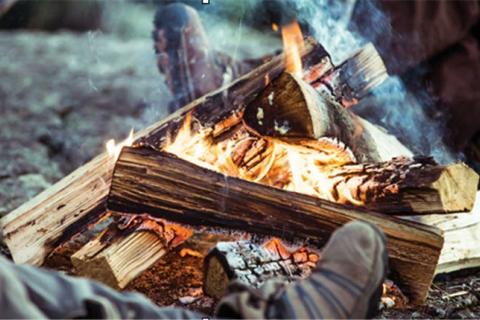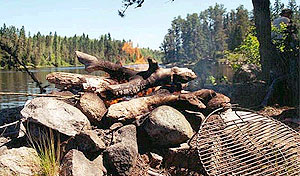
The sight was chilling, to say the least. My tent and everything inside it had burned to the ground. Nothing was left but a pile of charred fabric and blackened gear.
 I had been gone only a few minutes. A friend and I were camping near a backcountry lake, and needing some water for dinner preparation, I grabbed a jug and headed to the shore to fill it. In the brief time I was away, the wind shifted and apparently blew embers on the too-close tent, which caught fire. I was only 100 or so yards away, but never saw the resulting conflagration.
I had been gone only a few minutes. A friend and I were camping near a backcountry lake, and needing some water for dinner preparation, I grabbed a jug and headed to the shore to fill it. In the brief time I was away, the wind shifted and apparently blew embers on the too-close tent, which caught fire. I was only 100 or so yards away, but never saw the resulting conflagration.
I was only a teenager when that fire occurred. During the decades since, I have worked both as a park ranger and a volunteer fireman. While serving in those capacities, I saw many camping fires that got out of control and caused much more serious problems. In one instance, several hundred acres of forest burned when campers who were returning home left hot coals in their fire pit that reignited and caught the woods on fire. Another camper was severely burned while trying to light a campfire with gasoline. In yet another case, a candle burning in an RV ignited curtains and destroyed the camper. The owners were lucky to escape.
 |
| This diagram shows how your fire should be at least three meters from flammable objects. image by DFES |
Fires and camping seem almost inseparable. We use campfires for cooking and providing warmth. We use fire to light our surroundings and to provide that special ambience that is a part of the camp experience. We use fires of many sorts that are fueled by a variety of materials, including wood, propane and white gas.
Keep your camp and fellow campers safe by following all the rules for safe fire use when enjoying the outdoors.
![]() Click here to see a larger view of the Campfire Safety Diagram
Click here to see a larger view of the Campfire Safety Diagram
Campfire Safety and Building a Safe Campfire
 Before building a campfire, know all the local rules regarding open fires where you're camping. In many areas, campfires are allowed in designated areas only. And if conditions are dry or otherwise unfavorable, fires may be prohibited. Heed warnings from government agencies, and if it's windy or dry, don't build a fire.
Before building a campfire, know all the local rules regarding open fires where you're camping. In many areas, campfires are allowed in designated areas only. And if conditions are dry or otherwise unfavorable, fires may be prohibited. Heed warnings from government agencies, and if it's windy or dry, don't build a fire.
If a fire ring is available, use it. Otherwise, when preparing a campfire, select a site a safe distance away from grass, trees and tents.
An area 10 feet around the campfire should be cleared of ground litter, twigs, leaves and organic material, down to bare soil. The site also should be upwind from the sleeping area to prevent catching a tent or sleeping bag on fire from a spark or ember. Encircle the campfire pit with rocks.
There are a variety of products that may be safely used to help ignite your fire, but resist the temptation to use gasoline and other petroleum-based liquids, which can cause dangerous explosions. Build your fire with very small pieces of kindling laid first. Add small pieces of wood on top of the kindling, then continue adding larger pieces of wood on top of those. Keep your fire a manageable size, and keep a pail of sand or water nearby, along with a shovel, in case they are needed to control the fire or extinguish it. Pile extra firewood away from the flames, making sure it is upwind from the fire.
When the campfire is burning, someone should always attend it. Be sure flying embers don't land on anything flammable, and beware of sudden gusts of wind that can spread a fire. The fire should be extinguished when conditions are unsafe, before you bed down and any time you leave the campsite.
To put out a campfire, drown it with water. Make sure all embers, coals and pieces of wood are wet. Turn rocks and logs with a shovel so you can douse hot coals beneath them. Then use the shovel to stir the embers, add more water and stir again. Add still more water if necessary. Be sure all burning material has been extinguished and cooled.
Camp Stove, Lantern and Heater Safety
 |
| To keep the fire from spreading, encircle the campfire pit with dry rocks. |
When using propane, butane or liquid-fuel camp stoves, lanterns or catalytic heaters, know and follow the manufacturer's directions. Make sure all connections are tight to avoid leaks, but never check for a gas leak with a lighted match. Instead, put a little soapy water on the connections. If the mixture bubbles, gas is seeping out. Repair the item or have it checked by a professional.
Replenish the fuel supply of each item before using it. Use a funnel to avoid spilling liquid fuels, and clean up any excess immediately. Do not refuel a hot stove, lantern or heater. Wait until it cools before attempting to light it again. Fill lanterns and stoves a safe distance from campfires, grills and other sources of heat/open flame. And always fill them outside, never in a tent or camper.
Handle flammable liquids and fuel cylinders with care. Store them properly a safe distance from your tent, camper or any source of heat or open flame. Do not place them inside your tent or camper.
When your appliances are being used, place them so nothing flammable comes in contact with flames or hot parts. Avoid using fuel lanterns and stoves inside your tent.
Tent Fire Safety
Most tents today are manufactured from flame-resistant fabric, but flame-resistant doesn't mean fireproof. Always place tents a safe distance and upwind from open campfires. And clear ground debris away from the tent perimeter so sparks can't ignite anything.
Do all your cooking outside. A stove used in a tent could accidentally start a fire. Lighting should come from battery-operated sources. Avoid fuel lanterns or candles inside. If electric lights are used, keep hot bulbs away from anything flammable. When using heaters approved for tents, keep them away from walls, sleeping bags, pillows and other contents of the tent.
It's a good idea to keep a fire extinguisher in each tent, and be sure all campers know how to operate them. Battery-powered smoke detectors provide an added measure of precaution.
Camper / RV Fire Safety
When traveling with a camper trailer or recreational vehicle, use only electric or battery-operated lights inside. Maintain all appliances in a safe working condition and check them before use.
When the vehicle is traveling down the road, shut down gas to stoves and water heaters by closing the fuel supply at the gas bottle. Don't cook while the vehicle is underway. A sudden lurching of the vehicle may result in spilling of cooking oil, causing a fire.
Always use fuel stoves and lanterns outside campers and RVs. Accumulation of vapors in the fueling process could result in an explosion.
It's also wise to avoid accumulating and storing combustibles such as newspapers and grocery bags in your vehicle. Keep combustibles away from cooking and heating equipment.
Keep a fire extinguisher on board, preferably a multi-purpose one mounted by the exit door. Mount a battery-operated smoke detector inside the vehicle as well, and replace the batteries before each camping trip. And just in case the unthinkable happens, develop a fire escape plan with your family. It could save someone's life.
- 12318 views

